Da Nang
Nha Trang
Dalat
Sapa
Tam Dao
Vung Tau
Ha Long Bay
Phu Quoc
Hoi An
I’m a food blogger. My job is to find good food and tell people about it. When I was in Vietnam, Hue was on my list. It’s got a different food scene compared to Hanoi or Ho Chi Minh City. This place was once the imperial capital. That means you get fancy royal dishes alongside amazing street food. It’s a unique mix.
I wanted to find the best Hue food tour options. Not just what looked good online, but what was actually good to experience. I booked everything through GetYourGuide. It’s reliable, and you can see reviews from other travelers. This helped me pick solid tours.
Here’s my direct take. This is what I actually did, what I ate, and what I thought about each tour.
 0 – 60s
0 – 60s 0 – 60s
0 – 60s 0 – 60s
0 – 60s 0 – 60s
0 – 60s 0 – 60s
0 – 60s 0 – 60s
0 – 60s 0 – 60s
0 – 60s 0 – 60s
0 – 60s 0 – 60s
0 – 60s 0 – 60s
0 – 60s 0 – 60s
0 – 60s 0 – 60s
0 – 60s 0 – 60s
0 – 60s 0 – 60s
0 – 60s 0 – 60s
0 – 60s 0 – 60s
0 – 60s 0 – 60s
0 – 60s 0 – 60s
0 – 60s 0 – 60s
0 – 60s 0 – 60s
0 – 60s 0 – 60s
0 – 60s 0 – 60s
0 – 60s 0 – 60s
0 – 60s 0 – 60s
0 – 60s 0 – 60s
0 – 60s 0 – 60s
0 – 60s 0 – 60s
0 – 60sI looked for a dynamic way to explore Hue’s street food, and the Street Food Bike Tour on GetYourGuide caught my eye. It promised a guided bike tour, hitting various street food spots. This seemed like an active and engaging way to find the best Hue food tour experience on two wheels.





My guide met me at the Spatel d’Annam Hotel, the starting point. We had a quick safety briefing, then hopped on our bikes. It was a 2.5-hour tour. Biking through Hue’s streets felt immersive. You move at a good pace, get some exercise, and can really take in the local atmosphere as you go from one food stop to the next.
The guide made sure the menu worked for my preferences, though it’s important to note the tour description states it’s not suitable for vegans, vegetarians, or people with food allergies. This is a key point to remember when booking.
Our stops introduced us to a great variety of Hue’s local dishes. We tried bánh bèo, those delicate steamed rice cakes often served on small plates. Then bánh nậm, a flat, rectangular steamed rice cake, usually with shrimp, wrapped in a banana leaf. And bánh ít, a slightly different type of steamed sticky rice dumpling. These small cakes are Hue staples.
Another highlight was bánh cuốn thịt nướng, which are grilled pork wrapped in soft, thin rice rolls. The pork was flavorful and the soft rice paper was a nice contrast. We also definitely had to try bún bò Huế, the famous spicy beef noodle soup. It was rich, aromatic, and had that distinct kick that Hue’s soup is known for. It’s a very satisfying and iconic dish.
Towards the end, we also sampled bánh khoái (the crispy savory pancake) or chè (sweet soup), depending on what was available and recommended. Each food stop allowed for a refreshing beer or soft drink to pair with the food, adding to the local ambiance. My guide provided context about each dish and the local area.
This tour was ideal for foodies who are comfortable riding a bike and want to really dive into Hue’s authentic street food scene. It covers a solid range of key dishes and gives you a good feel for the city. The entire experience, including bike rental and all tastings, cost around $65 USD (approximately 1,630,000 VND).
Hotel pickup and drop-off are included, which is convenient. Remember to bring comfortable shoes, a hat, sunscreen, and water. This tour operates in all weather conditions, so dress appropriately. You can find and book the “Street Food Bike Tour” on GetYourGuide for current prices and availability.
After trying so much local food, I always want to know how it’s made. I like to cook, so a cooking class was next on my list. I picked the Hue Cooking Class and Market Tour because it started with a visit to a local market. To me, seeing the raw ingredients is a big part of understanding the food.





The day began early at Dong Ba Market. This is Hue’s largest and most famous market. It’s a busy place. Lots of people, sounds, and smells. My instructor, Trang, was a local chef. She was very lively and knew the market inside out. We walked through sections selling fresh vegetables, many different types of herbs I hadn’t seen before, spices, and pungent fermented sauces.
Trang showed us how to pick the best ingredients – how to choose a fresh banana flower, what to look for in good chili, and how to identify quality ingredients for Hue dishes. It was very practical information. You get a real sense of the local produce that makes Hue’s cuisine unique. This market visit alone was very informative.
From the market, we went to a clean, well-organized cooking studio. Each person had their own cooking station, with all the necessary ingredients already prepped and laid out. Our menu for the day included three classic Hue dishes: Nộm Hoa Chuối (banana flower salad), Thịt Kho Tàu (braised pork in coconut water), and Chả Giò (fried Vietnamese spring rolls).
Trang was a patient teacher. She demonstrated each step clearly, then we did it ourselves. For the banana flower salad, she showed us how to slice the banana flower very thinly and then immediately soak it in lime water. This prevents it from turning dark. That was a useful tip. For the braised pork, she taught us to caramelize sugar first. This step gives the dish its rich color and a deep, slightly sweet flavor.
Then we added the pork and coconut water and let it simmer for a long time. The pork became incredibly tender. For the spring rolls, rolling them tightly was the main challenge. If they’re not tight enough, they can break apart when fried. Trang showed us the proper technique. My first few were a bit messy, but I got better with practice.
The cooking session itself took about three hours after the market visit. Then, the best part, we ate everything we had cooked. The banana flower salad was fresh, tangy, and had a good crunch. The braised pork was melt-in-your-mouth tender, perfectly balanced between sweet and savory. And my own spring rolls came out perfectly crispy and delicious. It’s very satisfying to eat food you’ve prepared yourself, especially when it tastes this good. I didn’t just get recipes; I learned practical cooking skills and understood more about the reasons behind the cooking methods in Vietnamese cuisine.
This Hue food tour is great if you want a hands-on experience and want to learn how to cook authentic dishes. I paid around $45 USD (about 1,130,000 VND) for this class. That price covered the market tour, all the ingredients, and the cooking class itself. It felt like good value for the learning experience. You can find more details and book this class directly here.
I wanted a tour that specifically focused on tasting a wide range of Hue’s essential local dishes, going beyond just one or two types. I found the Local Food Tour. It promised to hit 6-8 different food spots and focus on popular local dishes. This looked like a solid best Hue food tour for someone who wants a broad tasting experience.

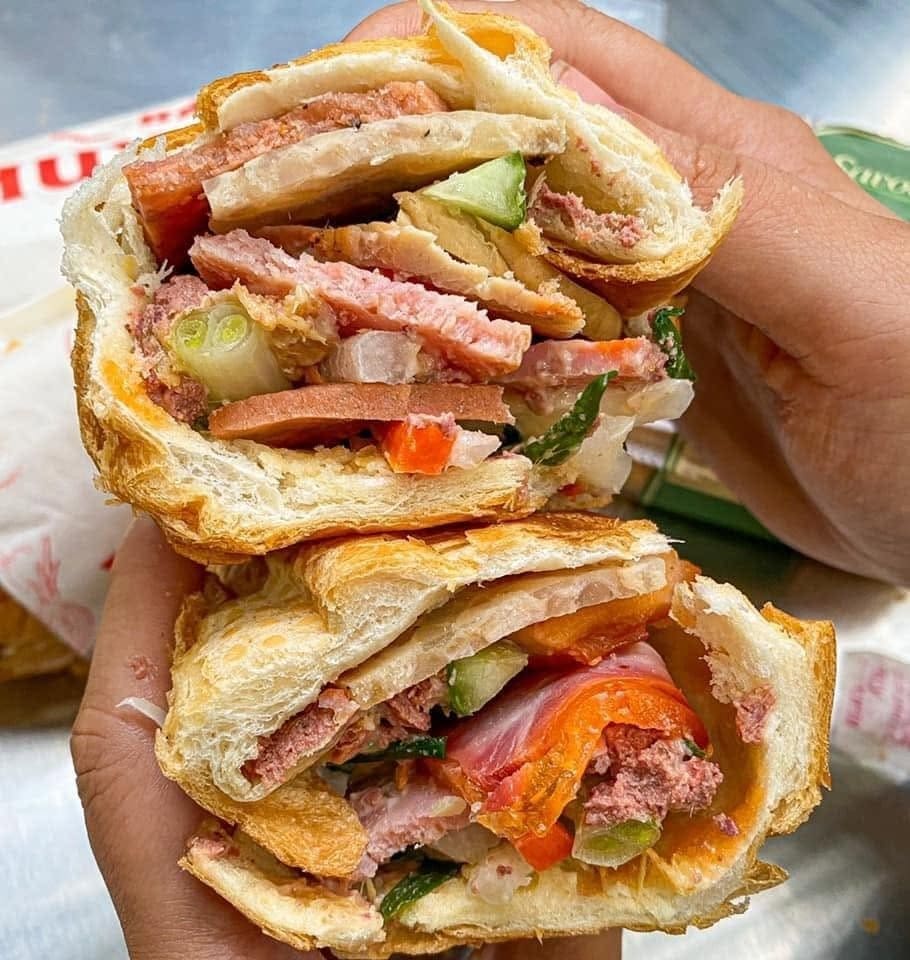

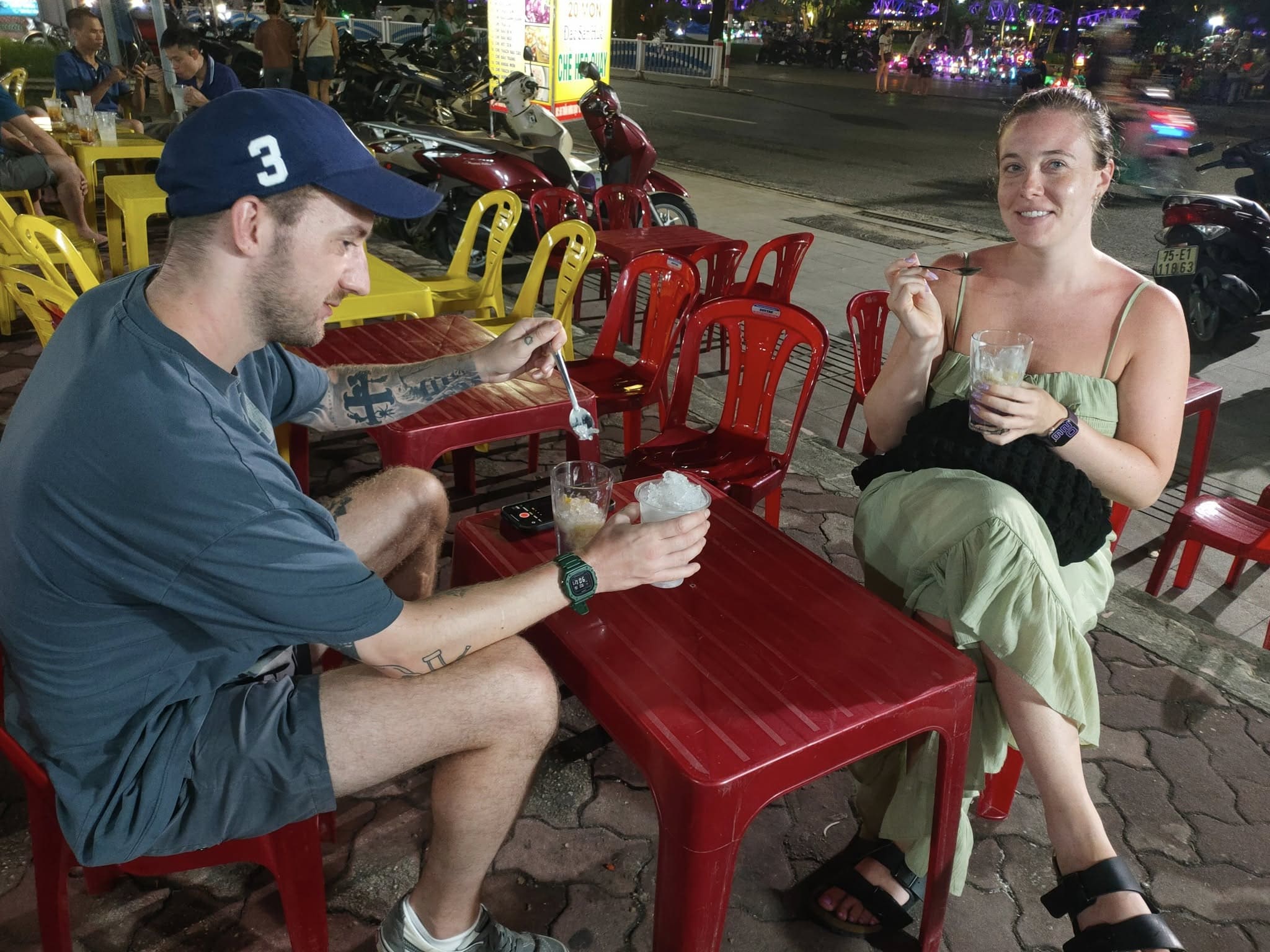
My guide for this tour was Ms. Thao. She was a local and knew the backstreets and local eateries very well. This tour was primarily a walking tour. We moved from one spot to another on foot, which allowed us to really explore specific neighborhoods and see the small, authentic food stalls up close. It was a good way to immerse myself in the daily food scene.
We visited several places, starting with the famous Hue savory cakes. We tried Banh Beo, those small steamed rice cakes. They were delicate, topped with crispy pork skin and dried shrimp. We also got Banh Loc, the clear, chewy tapioca dumplings, which were very flavorful with their shrimp and pork filling, often wrapped in banana leaves. And Banh Nam, the flat, rectangular steamed rice cakes, also with savory fillings, served on a banana leaf. Trying these different types side-by-side was great for understanding the variety of Hue’s cake specialties. Thao explained the different ingredients and cooking methods for each.
A key stop was for Nem Lui. This is a must-try in Hue. These are grilled pork skewers. We got them fresh off the grill, hot and smoky. You wrap the pork in rice paper with fresh herbs and dip it in the special peanut sauce. The freshness of the herbs balanced the rich pork.
We also had Bun Thit Nuong. This is grilled pork vermicelli. It’s a dry noodle dish, with tender grilled pork, fresh herbs, pickled vegetables, crushed peanuts, and a savory sauce poured over it. It’s a popular dish in Hue, especially for lunch or a light dinner. The combination of textures – soft noodles, crunchy peanuts, tender pork – was very good.
The tour usually finishes with Chè, traditional Hue sweet soups. We went to a local Chè stall. They had many varieties. I tried Chè Khoai Môn (taro sweet soup) and Chè Bắp (corn sweet soup). They were sweet, often with coconut milk, and refreshing. The guide explained how Chè is a common dessert or snack in Hue, and how locals often try different kinds.
This tour was great because it focused heavily on the food itself, making sure to hit many of Hue’s famous local dishes. It was a good paced walk, giving you time to observe the local life around the food stalls. It lasted about 3 hours. I paid around $35 USD (approximately 880,000 VND) for this tour. This price included all the food tastings and the guide. It felt like good value for trying such a wide variety of authentic Hue flavors. You can find this here for current prices and availability.
I wanted another evening food experience, but different from the Bike. I saw a Hue Night Foodie Tour by Cyclo. A cyclo is a bicycle rickshaw. It seemed like a relaxed way to see the city at night and find food spots. I booked it for a slower, more comfortable food adventure. This felt like a peaceful Hue food tour option for the evening.

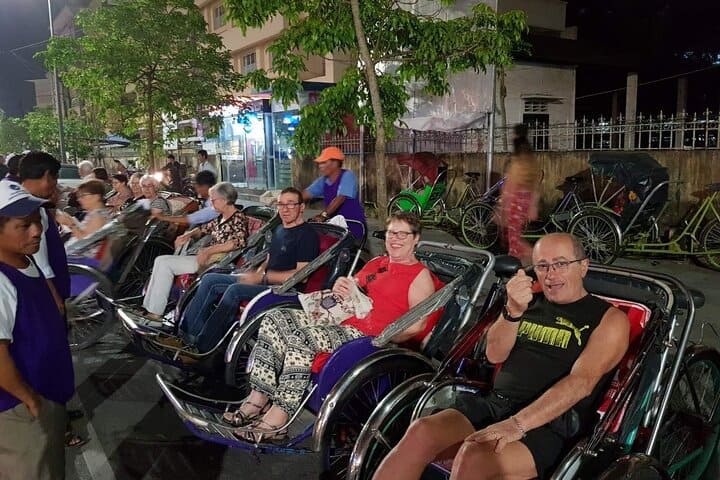

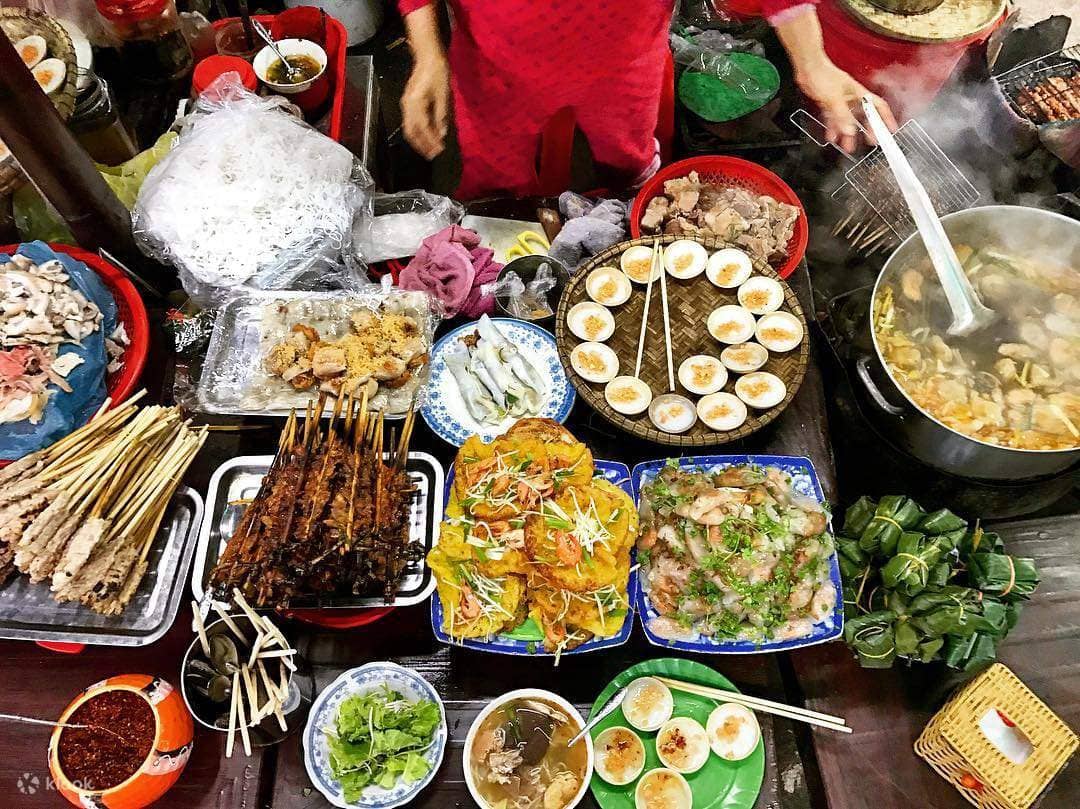
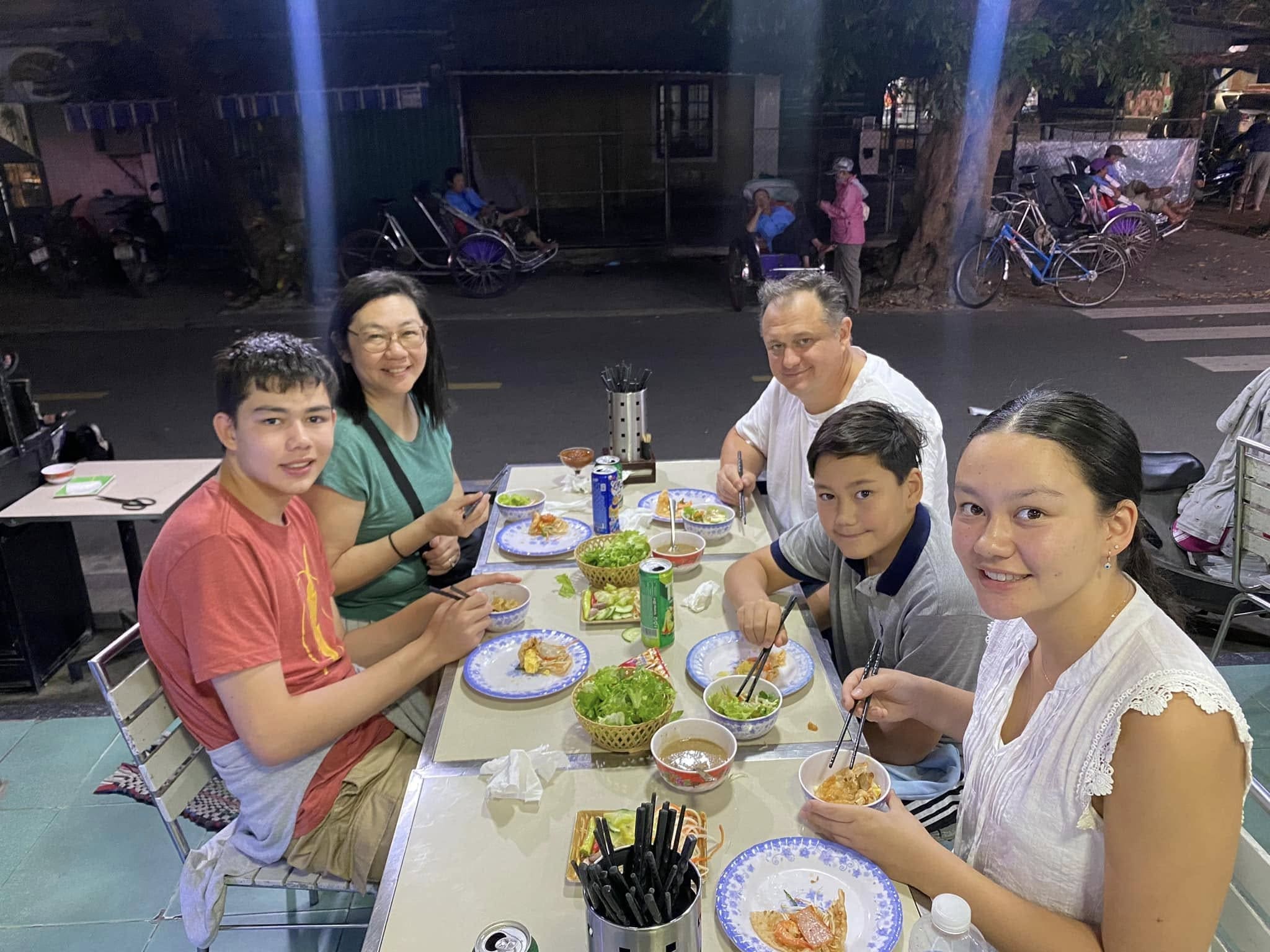
My cyclo driver and guide met me in the evening. Sitting in the front of the cyclo, with the driver pedaling behind, felt very traditional. It’s slower than a Bike, but you get a better view of the streets and local life as you pass by. The evening air was nice.
We started by heading to some popular street food areas. The first stop was for Banh Khoai. Yes, I had it on the Bike tour, but trying it from a different local spot is always interesting. This one was just as crispy and flavorful, served with the special peanut dipping sauce. It’s such a staple here. The guide explained how each family or vendor might have a slightly different recipe for the sauce.
Next, we went for Nem Lui, the grilled pork skewers. Again, a Hue classic. We got them fresh off the grill. The smoky pork, wrapped with fresh herbs and rice paper, then dipped in the savory sauce. It’s a perfect combination of textures and flavors. The cyclo driver waited patiently while we ate. It felt very relaxed, no rush.
One of the highlights of this tour was trying different kinds of Chè. We stopped at a popular Chè stall that had many varieties. I tried several small bowls: Chè Bột Lọc Heo Quay (sweet soup with tapioca dumplings and savory roasted pork – yes, sweet and savory in one!), and Chè Hạt Sen (sweet soup with lotus seeds). The Chè Bột Lọc Heo Quay was very unique – the savory pork in a sweet, often slightly thickened liquid. It’s a signature Hue dessert. The lotus seed Chè was lighter, with a subtle sweetness. The guide explained the history of Chè in Hue, how it’s a popular dessert and snack, and how many different kinds exist, some even linked to royal preferences.
The cyclo ride itself was a big part of the experience. It’s a quiet way to move through the busy streets. You can absorb the sights and sounds of Hue at night without being rushed. The guide shared insights about the areas we passed and the food we were trying. It was a comfortable and insightful way to spend an evening focused on Hue’s local flavors.
This Hue food tour is great if you want a relaxed, scenic, and delicious evening. It lasted about 2.5-3 hours. I paid around $30 USD (approximately 750,000 VND) for this tour. That included the cyclo ride and all the food tastings. It felt like good value for a unique evening. You can find and book similar Night Tour by Cyclo options on GetYourGuide.
Based on all these tours, here’s my straightforward advice for you:
Hue is just one incredible part of Vietnam’s food landscape. If you love food, you absolutely need to explore other regions too:
Hoi An: It’s a short trip from Hue. It has its own very distinct food. You must try Cao Lầu (unique noodles with pork and greens) and White Rose Dumplings (delicate shrimp dumplings). The fresh seafood here is also excellent. Hoi An also has many good cooking classes if you want another hands-on experience. I’ve written a blog post specifically about the best dishes to try in Hoi An that could be helpful for your next culinary stop.
Hanoi: The capital city is a huge street food destination. You have to try classic Pho (beef or chicken noodle soup) and Bun Cha (grilled pork with vermicelli noodles). And, of course, Banh Mi. Just walk around the Old Quarter; you’ll find amazing food everywhere.
Ho Chi Minh City (Saigon): This is a huge, vibrant city in the south. It has everything from high-end restaurants to bustling street food alleyways. Explore different districts, as each can have its own specialties. You might also find my guide on finding the best pho in Ho Chi Minh City useful if you plan to visit.
Mekong Delta: Down in the south. The food here is very fresh, often featuring river fish, plenty of fresh vegetables, and coconut-based dishes. Many boat tours in this region include stops at local eateries or floating markets where you can sample fresh produce and local snacks.
Eating your way through Vietnam is one of the best ways to experience the country. Every region tells a different story through its food. My best Hue food tour experiences were a real highlight of my trip. They helped me understand Hue and its culture through its amazing cuisine. I hope this detailed, practical guide helps you plan your own delicious adventure in Vietnam. Go to GetYourGuide. Find your perfect tour. And enjoy every bite!
No comments yet, let's be the first to comment 😊.
Get notified every time there's a new post. You can cancel at any time.
Share your experiences or just ask people a question? Click to see the community
Got a question or an idea you want to discuss? Start a discussion here to get opinions and connect with other members.
Have a story, valuable experience, or a detailed guide to share? Contribute a high-quality article to enrich our community.
To ensure quality, all new posts are not immediately visible on search engines like Google, Bing... Our team prioritizes reviewing high-value, insightful posts to feature publicly. You'll receive a notification when your contribution is selected!
Learn more about this feature:
This is Vietadvisor's "virtual assistant," using AI to generate questions or suggest additional related information right within the article you're reading. For example, if you're viewing an article about traveling in Da Lat, it might display "Have you tried Da Lat coffee yet?" or suggest "Learn more about Xuan Huong Lake." It helps you discover more without having to search yourself!
You will find the content more interesting and easier to understand. Instead of just reading the article with the main content only, you have additional questions to ponder or suggestions to delve deeper into the topic. It's like having a companion guiding you further in each reading.
Definitely! The AI is "trained" to stick closely to the content of the article. If you're reading about how to cook pho, you'll see questions like "What are the secrets to delicious pho broth?" instead of irrelevant content.
The questions and suggestions are generated based on data from reviewed articles and direct information from Google Gemini, ensuring high reliability. However, if you have doubts about any information, please contact us for further verification.
The AI relies on pre-trained data and current article content on Vietadvisor and real-time data from Google. We regularly update the system to ensure information reflects the latest trends, but you may want to double-check to confirm the level of updates.
The feature is applied to most articles, but it may not appear in some short or specialized content that is not suitable for adding questions and suggestions. We are expanding to ensure consistency across the entire Website.